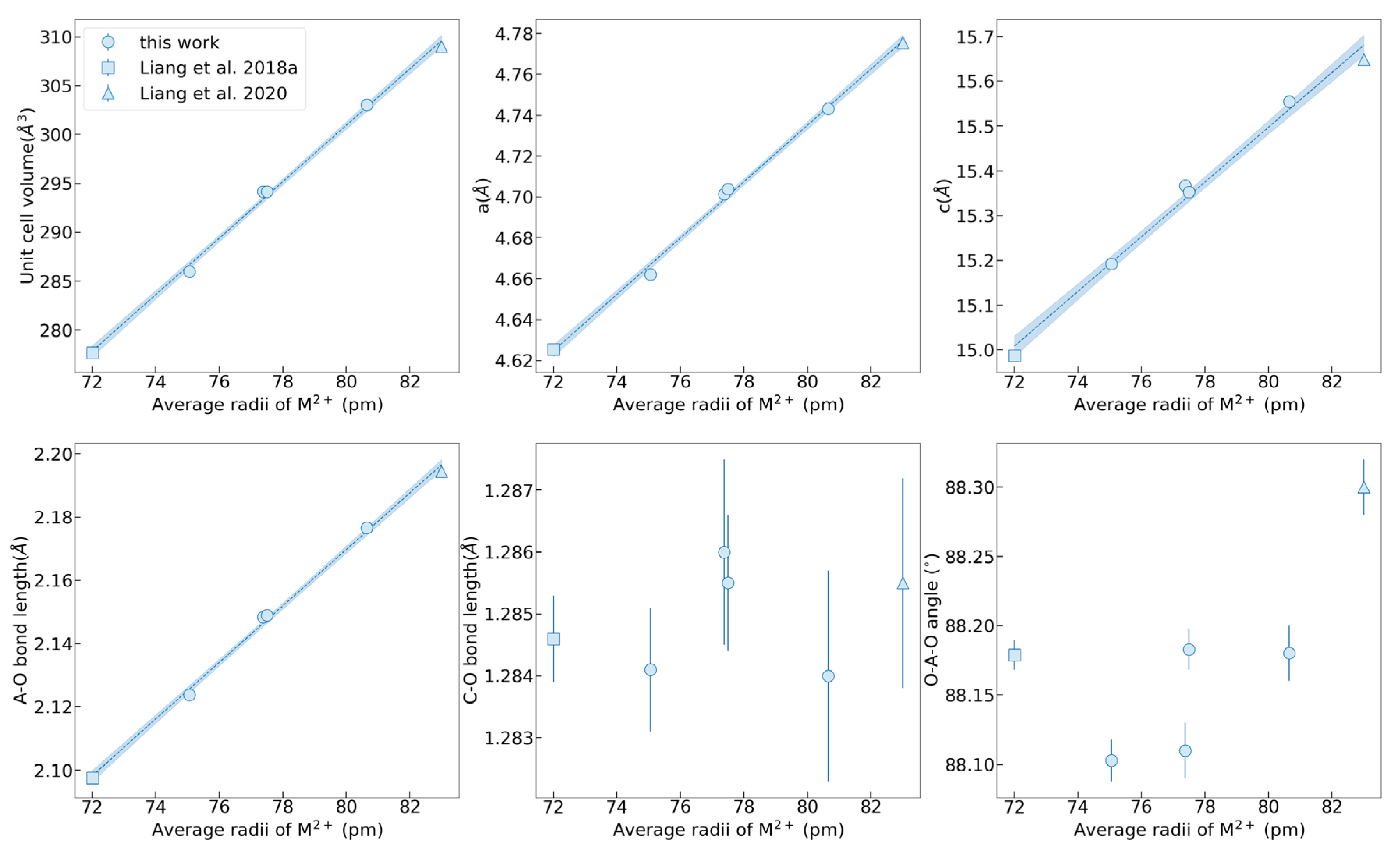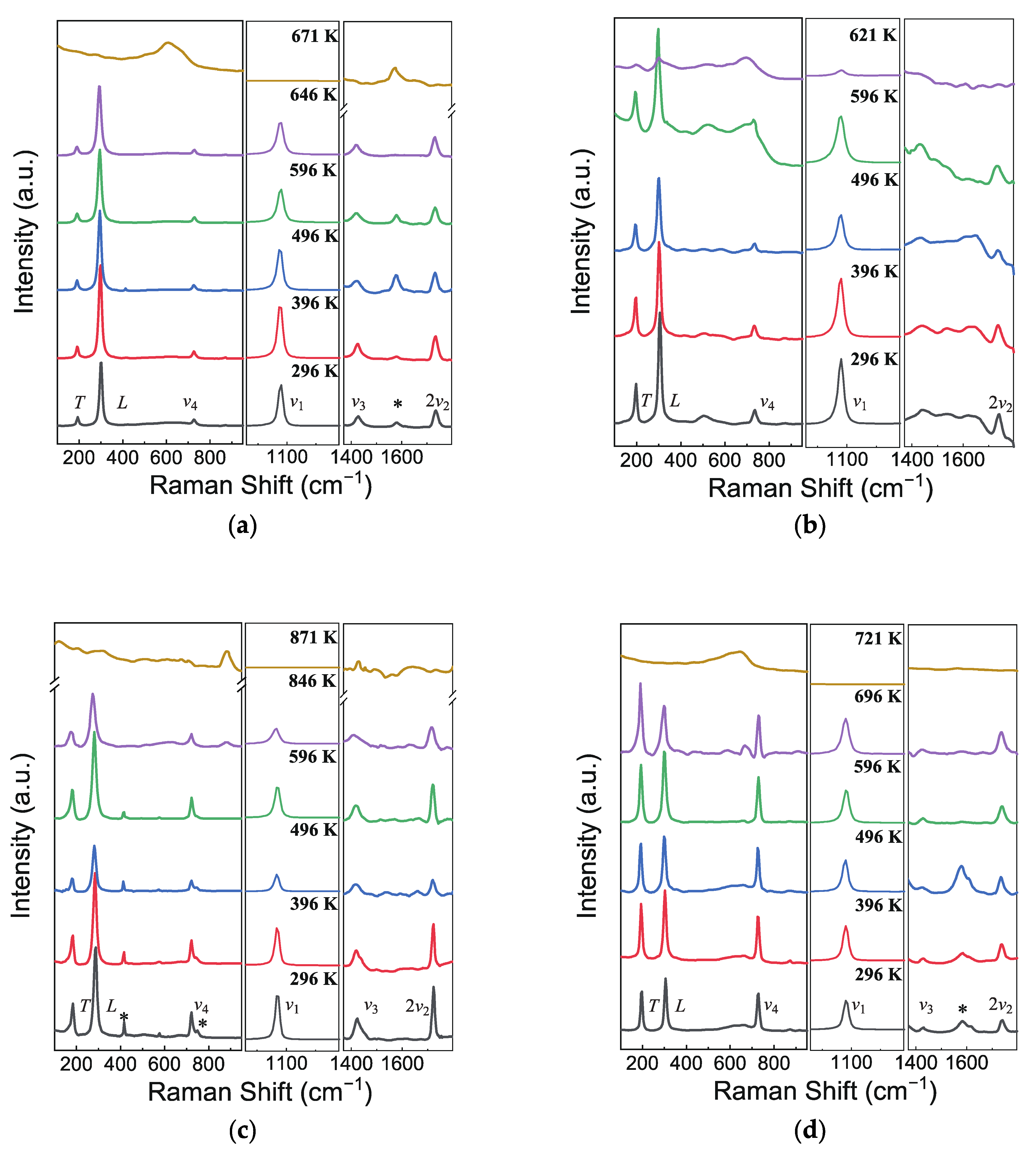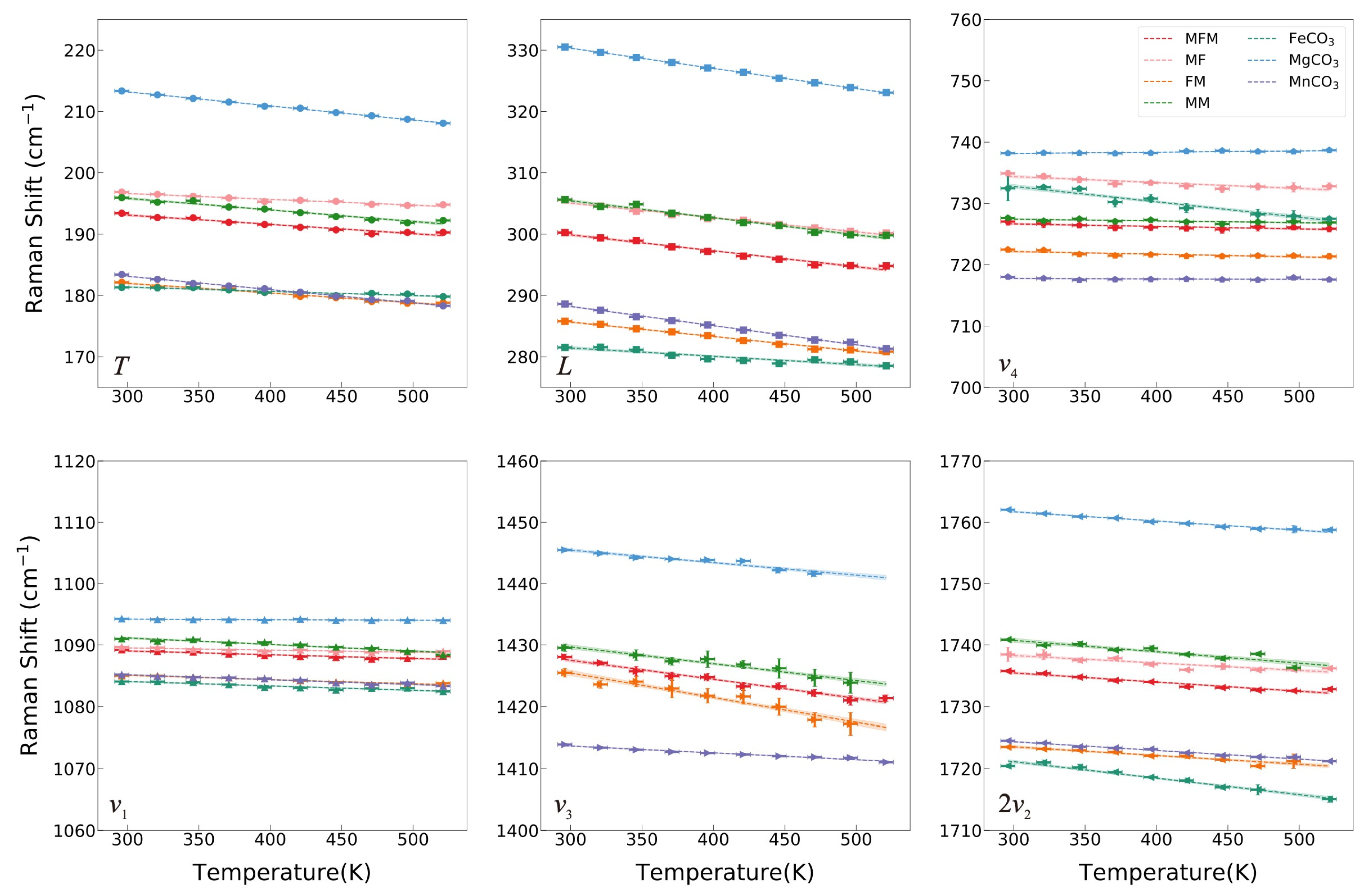In-Situ Single Crystal XRD and Raman Spectra Investigation of (Mg, Fe, Mn)CO3 at Various Temperatures
Abstract
1. Introduction
2. Materials and Methods
2.1. Sample Preparation and Characterization
2.2. Single Crystal X-ray Diffraction at Variable Temperature
2.3. High-Temperature Raman Spectroscopy
3. Results and Discussion
3.1. Single Crystal XRD and Thermal Expansion of (Mg, Fe, Mn)CO3 at Various Temperatures
3.2. Raman Spectra of (Mg, Mn, Fe)CO3 Carbonates at High Temperatures
3.3. Thermodynamic Grüneisen Parameters of the (Mg, Fe, Mn)CO3
3.4. The Effect of Fe2+ and Mn2+ Cation Substitution on (Mg, Fe, Mn)CO3
4. Conclusions
Supplementary Materials
Author Contributions
Funding
Data Availability Statement
Conflicts of Interest
References
- Alderton, D. Carbonates (Ca, Mg, Fe, Mn). In Reference Module in Earth Systems and Environmental Sciences; Elsevier: Amsterdam, The Netherlands, 2020; pp. 382–394. [Google Scholar] [CrossRef]
- Dasgupta, R.; Hirschmann, M.M. The deep carbon cycle and melting in Earth’s interior. Earth Planet. Sci. Lett. 2010, 298, 1–13. [Google Scholar] [CrossRef]
- Goldsmith, J.R.; Graf, D.L. Subsolidus Relations in the System CaCO3-MgCO3-MnCO3. J. Geol. 1960, 68, 324–335. [Google Scholar] [CrossRef]
- Palache, C.H.; Berman, H.; Frondel, H. Dana’s System of Mineralogy, 7th ed.; John Wiley & Sons: New York, NY, USA, 1951; Volume 2. [Google Scholar]
- Merlini, M.; Sapelli, F.; Fumagalli, P.; Gatta, G.D.; Lotti, P.; Tumiati, S.; Abdellatief, M.; Lausi, A.; Plaisier, J.; Hanfland, M.; et al. High-temperature and high-pressure behavior of carbonates in the ternary diagram CaCO3-MgCO3-FeCO3. Am. Miner. 2016, 101, 1423–1430. [Google Scholar] [CrossRef]
- Farsang, S.; Facq, S.; Redfern, S.A.T. Raman modes of carbonate minerals as pressure and temperature gauges up to 6 GPa and 500 degrees. Am. Miner. 2018, 103, 1988–1998. [Google Scholar] [CrossRef]
- Zhu, Y.; Li, Y.; Ding, H.; Lu, A.; Li, Y.; Wang, C. Multifactor-controlled mid-infrared spectral and emission characteristic of carbonate minerals (MCO3, M = Mg, Ca, Mn, Fe). Phys. Chem. Miner. 2021, 48, 15. [Google Scholar] [CrossRef]
- Wang, C.; Ren, L.; Walter, J.; Zhang, L.; Tao, R. In situ Raman vibrational spectra of siderite (FeCO3) and rhodochrosite (MnCO3) up to 47 GPa and 1100 K. Am. Miner. 2022. [Google Scholar] [CrossRef]
- Zhang, J.; Martinez, I.; Guyot, F.; Reeder, R.J. Effects of Mg-Fe2+ substitution in calcite-structure carbonates: Thermoelastic properties. Am. Miner. 1998, 83, 280–287. [Google Scholar] [CrossRef]
- Lavina, B.; Dera, P.; Downs, R.T.; Tschauner, O.; Yang, W.; Shebanova, O.; Shen, G. Effect of dilution on the spin pairing transition in rhombohedral carbonates. High Press. Res. 2010, 30, 224–229. [Google Scholar] [CrossRef]
- Spivak, A.; Solopova, N.; Cerantola, V.; Bykova, E.; Zakharchenko, E.; Dubrovinsky, L.; Litvin, Y. Raman study of MgCO3–FeCO3 carbonate solid solution at high pressures up to 55 GPa. Phys. Chem. Miner. 2014, 41, 633–638. [Google Scholar] [CrossRef]
- Chariton, S.; McCammon, C.; Vasiukov, D.M.; Stekiel, M.; Kantor, A.; Cerantola, V.; Kupenko, I.; Fedotenko, T.; Koemets, E.; Hanfland, M.; et al. Seismic detectability of carbonates in the deep Earth: A nuclear inelastic scattering study. Am. Miner. 2020, 105, 325–332. [Google Scholar] [CrossRef]
- Farfan, G.; Wang, S.; Ma, H.; Caracas, R.; Mao, W.L. Bonding and structural changes in siderite at high pressure. Am. Miner. 2012, 97, 1421–1426. [Google Scholar] [CrossRef]
- Farfan, G.; Boulard, E.; Wang, S.B.; Mao, W.L. Bonding and electronic changes in rhodochrosite at high pressure. Am. Miner. 2013, 98, 1817–1823. [Google Scholar] [CrossRef]
- Boulard, E.; Gloter, A.; Blanchard, M.; Mao, W.L. Pressure induced phase transition in MnCO3 and its implications on the deep carbon cycle: High Pressure Phase Transition in MnCO3. J. Geophys Res. Solid Earth 2015, 120, 4069–4079. [Google Scholar] [CrossRef]
- Hsu, H.; Huang, S.C. Spin crossover and hyperfine interactions of iron in (Mg, Fe)CO3 ferromagnesite. Phys. Rev. B 2016, 94, 060404. [Google Scholar] [CrossRef]
- Liu, J.; Fu, S.; Lin, J.F. Spin transition of iron in deep-mantle ferromagnesite. In Carbon in Earth’s Interior; American Geophysical Union: Washington, DC, USA, 2020. [Google Scholar] [CrossRef]
- Lobanov, S.S.; Goncharov, A.F. Pressure-induced sp2-sp3 transitions in carbon-bearing phases. In Carbon in Earth’s Interior; American Geophysical Union: Washington, DC, USA, 2020. [Google Scholar] [CrossRef]
- Liang, W.; Li, L.; Li, R.; Yin, Y.; Li, Z.M.; Liu, X.; Shan, S.; He, Y.; Meng, Y.; Li, Z.; et al. Crystal structure of impurity-free rhodochrosite (MnCO3) and thermal expansion properties. Phys. Chem. Miner. 2020, 45, 831–842. [Google Scholar] [CrossRef]
- Rosenberg, P.E. Synthetic solid solutions in the systems MgCO3-FeCO3 and MnCO3-FeCO3. Am. Miner. 1963, 48, 1396–1400. [Google Scholar]
- Goldsmith, J.R.; Graf, D.L.; Witters, J.; Northrop, D.A. Studies in the system CaCO3–MgCO3–FeCO3. J. Geol. 1962, 70, 659–688. [Google Scholar] [CrossRef]
- Lin, J.F.; Liu, J.; Jacobs, C.; Prakapenka, V.B. Vibrational and elastic properties of ferromagnesite across the electronic spin-pairing transition of iron. Am. Miner. 2012, 97, 583–591. [Google Scholar] [CrossRef]
- Liu, J.; Lin, J.F.; Mao, Z.; Prakapenka, V.B. Thermal equation of state and spin transition of magnesiosiderite at high pressure and temperature. Am. Miner. 2014, 99, 84–93. [Google Scholar] [CrossRef]
- Liang, W.; Li, Z.M.; Yin, Y.; Li, R.; Chen, L.; He, Y.; Dong, H.N.; Dai, L.D.; Li, H.P. Single crystal growth, characterization and high-pressure Raman spectroscopy of impurity-free magnesite (MgCO3). Phys. Chem. Miner. 2018, 45, 423–434. [Google Scholar] [CrossRef]
- Balarew, C.; Markov, L.; Petrov, K. On the crystal structure stability of calcite-type carbonates. Cryst. Res. Technol. 1985, 20, 1079–1084. [Google Scholar] [CrossRef]
- Effenberger, H.; Mereiter, K.; Zemann, J. Crystal structure refinements of magnesite, calcite, rhodochrosite, siderite, smithonite, and dolomite, with discussion of some aspects of the stereochemistry of calcite type carbonates. Z. Für Krist. Cryst. Mater. 1981, 156, 233–243. [Google Scholar] [CrossRef]
- Kyono, A.; Gramsch, S.A.; Yamanaka, T.; Ikuta, D.; Ahart, M.; Mysen, B.O.; Mao, H.K.; Hemley, R.J. The influence of the Jahn–Teller effect at Fe2+ on the structure of chromite at high pressure. Phys. Chem. Miner. 2012, 39, 131–141. [Google Scholar] [CrossRef]
- Markgraf, S.A.; Reeder, R.J. High-temperature structure refinements of calcite and magnesite. Am. Miner. 1985, 70, 590–600. [Google Scholar]
- Rutt, H.N.; Nicola, J.H. Raman spectra of carbonates of calcite structure. J. Phys. C Solid State Phys. 1974, 7, 4522–4528. [Google Scholar] [CrossRef]
- Gillet, P.; Biellmann, C.; Reynard, B.; Paul, M.M. Raman spectroscopic studies of carbonates part I: High-pressure and high-temperature behaviour of calcite, magnesite, dolomite and aragonite. Phys. Chem. Miner. 1993, 20, 1–18. [Google Scholar] [CrossRef]
- Gillet, P.; Guyot, F.; Malezieux, J. High-pressure and high-temperature Raman spectroscopy of Ca2GeO4: Some insights on anharmonicity. Phys. Earth Planet. Inter. 1989, 58, 141–154. [Google Scholar] [CrossRef]
- Zhang, J.; Martinez, I.; Guyot, F.; Gillet, P.; Saxena, S.K. X-ray diffraction study of magnesite at high pressure and high temperature. Phys. Chem. Miner. 1997, 24, 122–130. [Google Scholar] [CrossRef]
- Krishna Rao, K.V.; Satyanaryana Murthy, K. Thermal expansion of manganese carbonate. J. Mater. Sci. 1970, 5, 82–83. [Google Scholar] [CrossRef]
- Williams, Q.; Collerson, B.; Knittle, E. Vibrational spectra of magnesite (MgCO3) and calcite-III at high pressures. Am. Miner. 1992, 77, 1158–1165. [Google Scholar] [CrossRef]
- Megaw, H.D. Crystal structures and thermal expansion. Mater. Res. Bull. 1971, 6, 1007–1018. [Google Scholar] [CrossRef]






| a (10−6 K−1) | c (10−5 K−1) | V (10−5 K−1) | M-O (10−6 K−1) | C-O (10−6 K−1) | O-M-O (10−6 K−1) | VMO6 (10−6 K−1) | αc/αa | |
|---|---|---|---|---|---|---|---|---|
| Mg0.37Mn0.32Fe0.31CO3 | 6.19(19) | 18.24(5) | 3.06(7) | 13.0(2) | −2.0(6) | −0.033(2)°/100 K | 38.6(4) | 2.95 |
| Fe0.51Mg0.49CO3 | 6.09(10) | 18.65(7) | 3.08(7) | 14.1(2) | −6.1(9) | −0.027(3)°/100 K | 42.1(3) | 3.06 |
| Mn0.53Fe0.47CO3 | 5.23(7) | 16.10(13) | 2.65(12) | 13.2(4) | −8.6(4) | −0.017(3)°/100 K | 39.5(10) | 3.08 |
| Mg0.50Mn0.50CO3 | 5.36(15) | 19.00(7) | 2.97(8) | 13.0(5) | −4.2(9) | −0.036(3)°/100 K | 38.6(14) | 3.55 |
| MnCO3 a | 5.08 | 18.06 | 2.85 | 12.14 | −3.67 | −0.05°/100 K | 36.7 | 3.56 |
| MgCO3 b | 6.75 | 22.90 | 3.64 | 15.80 | −4.60 | −0.07°/100 °C | 46.9 | 3.39 |
| Observed Mode, Symmetry | νi (cm−1) | δνi/δT (cm−1/K) | γiP | γth | Reference |
|---|---|---|---|---|---|
| MgCO3 | |||||
| External T, Eg | 213 | −2.30(3) × 10−2 | 2.80 | 1.13 | This work |
| 214 | −2.05(5) × 10−2 | 4.95 | Farsang et al. 2018 [6] | ||
| 213 | −9(2) × 10−3 | 2.40 | Gillet et al. 1993 [30] | ||
| External L, Eg | 330 | −3.29(2) × 10−2 | 2.59 | This work | |
| 330 | −3.01(5) × 10−2 | 4.73 | Farsang et al. 2018 [6] | ||
| 329 | −1.9(3) × 10−2 | 3.00 | Gillet et al. 1993 [30] | ||
| Internal ν4, Eg | 738 | 2.14(5) × 10−3 | −0.08 | This work | |
| 738 | −2.0(8) × 10−3 | 0.14 | Farsang et al. 2018 [6] | ||
| 738 | 0 | 0.00 | Gillet et al. 1993 | ||
| Internal ν1, A1g | 1094 | −9(2) × 10−4 | 0.02 | This work | |
| 1094 | −1.4(7) × 10−3 | 0.07 | Farsang et al. 2018 [6] | ||
| 1094 | −3.5(3) × 10−3 | 0.17 | Gillet et al. 1993 [30] | ||
| Internal ν3, Eg | 1446 | −2.0(2) × 10−2 | 0.37 | This work | |
| 1446 | ? | Farsang et al. 2018 [6] | |||
| 1444 | −3.0(3) × 10−2 | 1.08 | Gillet et al. 1993 [30] | ||
| Overtone 2v2 | 1762 | −1.51(9) × 10−2 | 0.22 | This work | |
| 1763 | −1.63(8) × 10−2 | 0.48 | Farsang et al. 2018 [6] | ||
| 1762 | −2.6(3) × 10−2 | 0.76 | Gillet et al. 1993 [30] | ||
| MnCO3 | |||||
| External T, Eg | 183 | −2.17(6) × 10−2 | 4.15 | 1.53 | This work |
| 184 | −3.63(0) × 10−2 | 8.63 | Wang et al. 2022 [8] | ||
| 185 | −1.98(6) × 10−2 | 4.63 | Farsang et al. 2018 [6] | ||
| External L, Eg | 288 | −3.13(8) × 10−2 | 3.81 | This work | |
| 289 | −3.37(0) × 10−2 | 5.10 | Wang et al. 2022 [8] | ||
| 290 | −2.93(6) × 10−2 | 4.43 | Farsang et al. 2018 [6] | ||
| Internal ν4, Eg | 718 | −7(8) × 10−4 | 0.04 | This work | |
| 719 | −8.17(0) × 10−3 | 0.50 | Wang et al. 2022 [8] | ||
| 718 | −1.4(8) × 10−4 | −0.09 | Farsang et al. 2018 [6] | ||
| Internal ν1, A1g | 1085 | −7.9(7) × 10−3 | 0.25 | This work | |
| 1086 | −1.03(3) × 10−2 | 0.43 | Wang et al. 2022 [8] | ||
| 1086 | −5.8(7) × 10−3 | 0.22 | Farsang et al. 2018 [6] | ||
| Internal ν3, Eg | 1414 | −1.11(7) × 10−2 | 0.27 | This work | |
| 1415 | ? | ? | Farsang et al. 2018 [6] | ||
| Overtone 2v2 | 1724 | −1.41(7) × 10−2 | 0.29 | This work | |
| 1727 | −1.3(1) × 10−2 | 0.31 | Farsang et al. 2018 [6] | ||
| FeCO3 | |||||
| External T, Eg | 181 | −6.9(9) × 10−3 | 1.35 | 0.89 | This work |
| 183 | −6.3(4) × 10−3 | 1.16 | Wang et al. 2022 [8] | ||
| 183 | 1(1) × 10−3 | −0.17 | Farsang et al. 2018 [6] | ||
| External L, Eg | 281 | −1.36(18) × 10−2 | 1.73 | This work | |
| 283 | −1.47(3) × 10−2 | 1.74 | Wang et al. 2022 [8] | ||
| 284 | −1.0(1) × 10−2 | 1.31 | Farsang et al. 2018 [6] | ||
| Internal ν4, Eg | 733 | −2.5(2) × 10−2 | 1.22 | This work | |
| 731 | −1.35(9) × 10−2 | 0.68 | Farsang et al. 2018 [6] | ||
| Internal ν1, A1g | 1084 | −7.1(9) × 10−3 | 0.23 | This work | |
| 1085 | −7.1(3) × 10−3 | 0.22 | Wang et al. 2022 [8] | ||
| 1085 | −3(1) × 10−3 | 0.10 | Farsang et al. 2018 [6] | ||
| Overtone 2v2 | 1721 | −2.67(19) × 10−2 | 0.55 | This work | |
| 1724 | −1.6(1) × 10−2 | 0.35 | Farsang et al. 2018 [6] | ||
| Mg0.37Fe0.31Mn0.32CO3 | |||||
| External T, Eg | 193 | −1.5(1) × 10−2 | 2.6(3) | 1.18 | This work |
| External L, Eg | 300 | −2.6(2) × 10−2 | 2.8(2) | This work | |
| Internal ν4, Eg | 727 | −0.4(1) × 10−2 | 0.19(6) | This work | |
| Internal ν1, A1g | 1089 | −0.6(1) × 10−2 | 0.18(4) | This work | |
| Internal ν3, Eg | 1428 | −3.1(2) × 10−2 | 0.70(6) | This work | |
| Overtone 2v2 | 1736 | −1.5(1) × 10−2 | 0.28(3) | This work | |
| Mg0.49Fe0.51CO3 | |||||
| External T, Eg | 197 | −1.0(1) × 10−2 | 1.6(2) | 0.82 | This work |
| External L, Eg | 305 | −2.3(1) × 10−2 | 2.5(2) | This work | |
| Internal ν4, Eg | 734 | −1.0(2) × 10−2 | 0.43(9) | This work | |
| Internal ν1, A1g | 1090 | −0.4(1) × 10−2 | 0.11(2) | This work | |
| Overtone 2v2 | 1738 | −1.2(2) × 10−2 | 0.23(4) | This work | |
| Fe0.47Mn0.53CO3 | |||||
| External T, Eg | 182 | −1.6(1) × 10−2 | 3.3(4) | 1.36 | This work |
| External L, Eg | 286 | −2.4(1) × 10−2 | 3.1(3) | This work | |
| Internal ν4, Eg | 722 | −0.4(1) × 10−2 | 0.23(7) | This work | |
| Internal ν1, A1g | 1085 | −0.7(1) × 10−2 | 0.24(3) | This work | |
| Internal ν3, Eg | 1426 | −4.0(4) × 10−2 | 1.1(1) | This work | |
| Overtone 2v2 | 1724 | −1.4(2) × 10−2 | 0.31(5) | This work | |
| Mg0.50Mn0.50CO3 | |||||
| External T, Eg | 196 | −2.0(1) × 10−2 | 3.2(3) | 1.34 | This work |
| External L, Eg | 306 | −2.8(2) × 10−2 | 3.1(3) | This work | |
| Internal ν4, Eg | 727 | −0.3(1) × 10−2 | 0.13(5) | This work | |
| Internal ν1, A1g | 1091 | −1.1(1) × 10−2 | 0.33(4) | This work | |
| Internal ν3, Eg | 1430 | −2.7(3) × 10−2 | 0.64(8) | This work | |
| Overtone 2v2 | 1741 | −1.9(3) × 10−2 | 0.36(7) | This work | |
Disclaimer/Publisher’s Note: The statements, opinions and data contained in all publications are solely those of the individual author(s) and contributor(s) and not of MDPI and/or the editor(s). MDPI and/or the editor(s) disclaim responsibility for any injury to people or property resulting from any ideas, methods, instructions or products referred to in the content. |
© 2023 by the authors. Licensee MDPI, Basel, Switzerland. This article is an open access article distributed under the terms and conditions of the Creative Commons Attribution (CC BY) license (https://creativecommons.org/licenses/by/4.0/).
Share and Cite
Liang, L.; Bao, X.; Liang, W.; Song, H.; Wu, X.; Qin, S. In-Situ Single Crystal XRD and Raman Spectra Investigation of (Mg, Fe, Mn)CO3 at Various Temperatures. Minerals 2023, 13, 207. https://doi.org/10.3390/min13020207
Liang L, Bao X, Liang W, Song H, Wu X, Qin S. In-Situ Single Crystal XRD and Raman Spectra Investigation of (Mg, Fe, Mn)CO3 at Various Temperatures. Minerals. 2023; 13(2):207. https://doi.org/10.3390/min13020207
Chicago/Turabian StyleLiang, Lin, Xinjian Bao, Wen Liang, Haipeng Song, Xiang Wu, and Shan Qin. 2023. "In-Situ Single Crystal XRD and Raman Spectra Investigation of (Mg, Fe, Mn)CO3 at Various Temperatures" Minerals 13, no. 2: 207. https://doi.org/10.3390/min13020207
APA StyleLiang, L., Bao, X., Liang, W., Song, H., Wu, X., & Qin, S. (2023). In-Situ Single Crystal XRD and Raman Spectra Investigation of (Mg, Fe, Mn)CO3 at Various Temperatures. Minerals, 13(2), 207. https://doi.org/10.3390/min13020207







